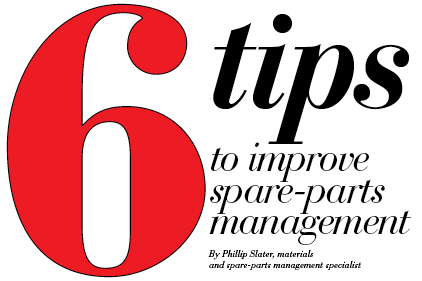Yet, spare parts are also the most overlooked contributor to reliability outcomes. Our research has shown that many companies routinely operate without properly implementing even the most fundamental aspects of spare parts management at their sites. Often these companies have storerooms with neat shelves and clear labels — but this is not enough for highly reliable spare parts management. To help make a difference in your operational reliability here are six tips to improve your spare parts management.
No. 1: Develop Clear Spare Parts Stocking Criteria
“To stock or not to stock,” that is the question. One of the major flaws in most spare parts management systems is the absence of clear criteria on when to stock an item and when not to stock an item. The absence of any guidelines forces your team into a process of ad hoc and inconsistent decision-making. The result is that you stock items that don’t require stocking and don’t stock items (sometimes critical items) that you should. To avoid this, you need to develop and implement specific guidelines to aid decision-making on when to stock an item and when to not stock an item.
No. 2: Provide Clear
Guidelines on How Many Parts to Stock
Once you have established clear spare parts stocking criteria, the next step is to establish clear guidelines on how many of an item to stock. By developing and implementing clear stocking guidelines, you provide the logic for decision-making on stock levels and calculating reorder quantities. The advantage of this is that it provides guidance to your team, continuity for decision-making, and provides the basis for future audits of inventory holdings.
No. 3: Accept that Some Stock Outs are OK
One of the main fears of most reliability and maintenance engineers is that, at the time of actual need, the required spare part will not be available. This is commonly referred to as a stock out. But how do you eliminate all stock outs? The short answer is, you can’t, not without tying up massive amounts of money that would be better used elsewhere. Even then, it’s not 100 percent guaranteed that you could eliminate all stock outs. This would possibly require holding multiple units of every part in your plant. That’s not viable. That’s the truth. What you can do is accept stock outs in areas where they have little or no impact or where a viable supply alternative exists. Then work to eliminate stock outs for the items that really matter.
No. 4: Review the
Holdings of Critical Spare Parts
Maintenance and reliability engineers will happily (well, not happily) undertake a review of spare parts that are not classified as critical, yet they will shy away from reviewing items that are classified as critical. The argument is: “The item is critical, and so we must stock it.” Thus the classification drives the review action rather than a cost benefit or stocking analysis. But what if the classification was wrong, or the item was significantly overstocked, or the supply arrangements had changed? Surely these are factors that can be reviewed and have nothing to do with the part’s criticality? It doesn’t make sense to limit your reviews based on the idea of criticality. This will drive you to review parts that are critical but not defined as such, and to not review parts that are defined as critical but which may no longer be critical. Critical parts may be just as overstocked as any other item, or there just might be a viable alternative to holding the item at all.
No. 5: Identify Causes of
Excess Inventory
The impact of not holding a required spare part can be massive. Downtime costs often far outweigh the purchase and holding costs of spares and this can lead to holding far more of some spares than is really required. As a result, accountants will often target this as an area of easy cost savings. If you want to keep the accountants off your back and maintain control of your spares holdings, it is important to regularly review your inventory and eliminate excess spare parts holdings. To do this most effectively, inventory reviews need to focus on much more than just data analytics. The real drivers of excess inventory lay in the processes and decision-making that influences your inventory levels, with the most common culprit being the returns process.
No. 6: Review Your
Storeroom Security
Many companies are fully aware of the importance of maintaining security around their spare parts inventories. They secure their spares in lock-up areas, ensure staff is on hand to manage the level of spares requests during periods of high maintenance activity, and provide a rock-solid approach for identifying storeroom entrants during the afternoon and night shifts. Then they leave the back door open! To “make life easier,” there is often a gate left open, through which anyone can enter. While the efficiency in terms of supplying spares and minimizing downtime is obvious, this practice actually puts your reliability at risk. Removing items from the storeroom without proper record, no matter how honest the intent, will not trigger reordering when required, and next time you need that item, it will not be in stock.
Spare parts management is like every other aspect of operations management: Success requires clear guidelines, differentiation of outcomes, critical evaluation and discipline in execution. Follow these six spares management tips, and you will go a long way to achieving the operational reliability that you need.






Report Abusive Comment